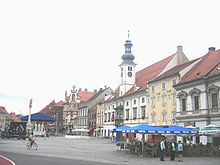Marburg Bloody Sunday
The bloody smashing of a demonstration by Slovenian Germans in the city of Marburg an der Drau (Maribor) by soldiers of the SHS Army on January 27, 1919 is called Marburg Blood Sunday . 13 German civilians in Marburg were killed and around 60 injured.
Incursion of the Slovenian military
During the disintegration of the Habsburg Monarchy ( Austria-Hungary ) in the late phase of the First World War , Marburg, then the second largest city in Styria, was occupied by Slovenian Landsturm units on November 1, 1918 . They were under the command of the Austro-Hungarian captain Rudolf Maister , the commander of the Landsturm District Command No. 26. Maister's troops also occupied all the surrounding areas and in some cases penetrated northwards across the German-Slovenian language border ( Radkersburg , Spielfeld , Mureck , Abstall , etc.) in front. Maister had the German people's defense units and police officers disarmed and most of them deported north to the newly emerging Republic of German Austria . With the consent of Ljubljana, he proclaimed himself city commander of Marburg, which was 80% German-speaking at the time, deposed the elected mayor and the city council , and began to Slovene the city. All German-speaking officials were dismissed and, if they did not have the right to live in Marburg, they were deported. Resistance was prevented by arbitrary arrest of hostages .
Bloody suppression of the demonstration
Since it but in the city Radkersburg had come to a successful resistance voluntary German Austrian associations and the newly formed Republic of German Austria claimed the predominantly German-speaking area of Marburg and the surrounding area, a delegation of the announced for the January 27, 1919 United States (US Coolidge Commission ) under Colonel Sherman Miles to get an idea of the ethnic situation in Marburg. A part of the German population of Marburg and the surrounding area then gathered in front of the town hall and showed their will to stay with Austria by means of their Austrian and German flags. During the demonstration, Slovenian soldiers opened fire on the demonstrators. While the Germans testified that Maister had the non-violent and unarmed crowd shot without warning, Slovenian eyewitnesses claimed that German civilians tried to storm the town hall and that the first shots were fired by a German. After the crackdown on a South Slav officer, the Yugoslav troops opened fire without command. The objection to this version, however, is that it only emerged later, that there were no injuries or deaths among the Slovenian occupation soldiers and that Maister had previously confiscated all weapons in the city by taking hostages. In total, there were - including those who died in the hospital - 13 dead and 60 injured German civilians from Marburg and the surrounding area. Due to these events, the German Marburgs could not submit their demands to the US Commission. According to Slovenian information, however, the shootings are said to have turned the Americans against the Slovenian side. This was countered by the German side that the US commission found no more traces of the massacre .
Immediately after the bloodbath, General Maister had the German-language daily Marburger Zeitung banned.
Joins the Kingdom of Yugoslavia
In contrast to the Carinthian defensive struggle , in which military resistance was offered in Carinthia to the occupation by SHS units, the Styrian provincial government renounced any organized military resistance (the German-Austrian units in Radkersburg were not under their command) and relied on the justice of the victorious powers to draw the new state borders according to ethnic circumstances ( Wilsons 14 points ).
In the autumn of 1919, Marburg and the surrounding area were joined to the Kingdom of Serbs, Croats and Slovenes , later called Yugoslavia , in the Treaty of Saint-Germain without a referendum and against the declared will of the former mayor, municipal council, state parliament and Reichsrat members . Germans who had remained in the city after the consequent Sloveneization of Marburg were largely expelled in 1945.
swell
Contemporary Austrian sources
- Article in: Die Neue Zeitung , January 29, 1919, p. 1 (online at ANNO ).
- Article in: Pester Lloyd , January 29, 1919, p. 4 (online at ANNO ).
- Article in: Wiener Allgemeine Zeitung , January 28, 1919, p. 4 (online at ANNO ).
- Article in: Reichspost , January 29, 1919, p. 4 (online at ANNO ).
Slovenian sources
Individual evidence
- ↑ Joachim Hösler, Slovenia , Regensburg 2006, p. 148
